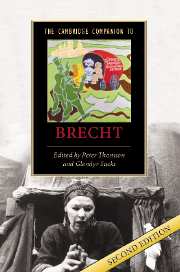Book contents
- Frontmatter
- Part I Context and Life
- Part II The Plays
- 4 Brecht’s early plays
- 5 The Threepenny Opera
- 6 Brecht’s clowns: Man is Man and after
- 7 Learning for a new society: the Lehrstück
- 8 The Good Person of Szechwan
- 9 Mother Courage and Her Children
- 10 Life of Galileo: between contemplation and the command to participate
- 11 The Caucasian Chalk Circle: the view from Europe
- Part III Theories and Practices
- Bibliography
- Index
- Series List
5 - The Threepenny Opera
from Part II - The Plays
Published online by Cambridge University Press: 28 March 2007
- Frontmatter
- Part I Context and Life
- Part II The Plays
- 4 Brecht’s early plays
- 5 The Threepenny Opera
- 6 Brecht’s clowns: Man is Man and after
- 7 Learning for a new society: the Lehrstück
- 8 The Good Person of Szechwan
- 9 Mother Courage and Her Children
- 10 Life of Galileo: between contemplation and the command to participate
- 11 The Caucasian Chalk Circle: the view from Europe
- Part III Theories and Practices
- Bibliography
- Index
- Series List
Summary
The Threepenny Opera is unique. Since its first performance in Berlin, at the Theater am Schiffbauerdamm on 31 August 1928, it has enjoyed a popularity matched only by the best-known Broadway musicals or the most established operas. It has led a protean existence in commercial theatres, in subsidised regional and national theatres and in opera houses. It has spawned a film, a novel and countless recordings of its music by a bewildering range of performers.
Yet it is clearly not an opera in any conventional sense; the word opera in the title implies a parody. Formally the music is too disunited to make it, for its time, a 'proper' opera, even though operatic devices such as recitative, ensembles and choruses are used. Neither is it a musical in the sense that we now accept the term, even though the Marc Blitzstein revival in the 1950s ran in New York for more than 2,500 performances. Successful Broadway musicals tend to have socially conventional plots with plenty of spectacle and picturesque romanticism, not Marxist-inspired social criticism as their motivation.
It is worth getting to know Kurt Weill a little better before going on to the work itself in more detail. Weill is a paradoxical character; a classically trained composer who in his youth was regarded as at the leading edge of the avant-garde, but who wrote 'Mac the Knife' - one of the most ubiquitous and durable popular tunes of the century.
- Type
- Chapter
- Information
- The Cambridge Companion to Brecht , pp. 78 - 89Publisher: Cambridge University PressPrint publication year: 2006

